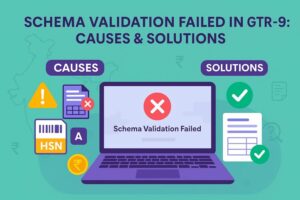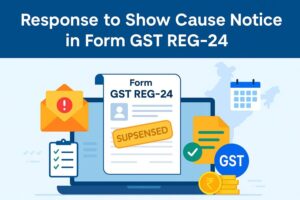Form DRC 07 in GST: Summary of Order
- 23 Dec 24
- 18 mins

Form DRC 07 in GST: Summary of Order
- What Is Form DRC-07 in GST?
- GST Rules on the Use of DRC-07
- DRC-07 Time Limit for Appeal
- How to File Form DRC-07 in GST?
- Exploring the Legal Framework of DRC-07 Summary Orders
- Importance of Compliance with DRC-07 Summary Orders
- Challenges and Complexities in Implementing DRC-07 Summary Orders
- DRC-07 Among Other GST Notices
- How Does DRC-07 Differ from Other GST Notices?
- Common Mistakes and Tips for Compliance with DRC-07
- Ways to Avoid Issuance of Notices
- Process of Replying to Form DRC-07
- Importance of Timely Response to DRC-07 Notice
- Conclusion
Key Takeaways
- DRC-07 Purpose: Issued to notify taxpayers of confirmed GST liabilities for payment or appeal.
- Response Deadline: Taxpayers must act within 30 days to avoid penalties or legal action.
- Appeal Process: Contest demands using Form GST APL-01 with supporting documents.
- Compliance Benefits: Timely response ensures legal compliance and avoids penalties.
- Prevent Notices: Regular reconciliation and accurate filings help avoid DRC-07 notices.
DRC-07 in GST is one of the forms that a proper officer issues to taxpayers on behalf of the GST authority. A tax officer can issue this form if he/she identifies discrepancies in tax returns or ITC claims by the GSTIN holder.
The taxpayer can respond to the notice in an appeal if he/she disagrees with the tax demands in Form DRC-07. If the taxpayer accepts the tax liabilities mentioned in the notice, he/she has to pay the outstanding dues. Learn in detail about DRC-07 here to make informed decisions.
What Is Form DRC-07 in GST?
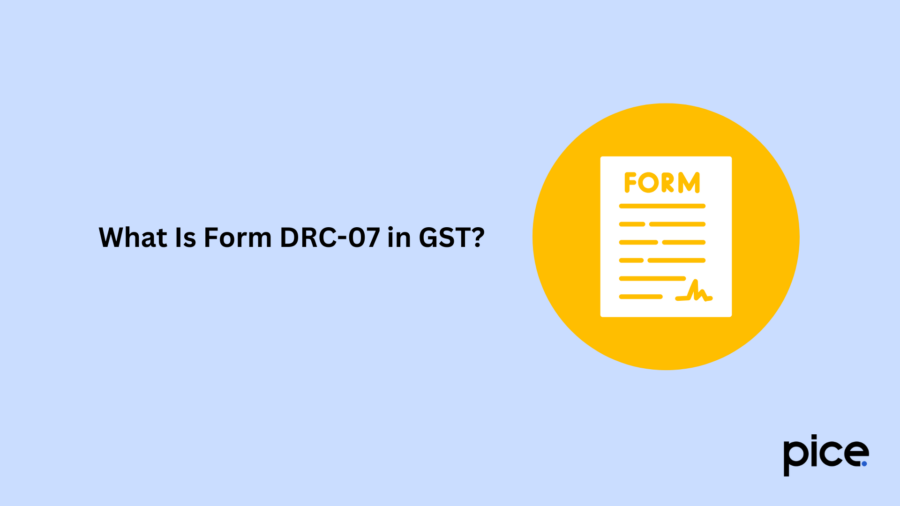
The tax authorities issue DRC-07 forms to taxpayers to recover GST dues and outstanding tax liabilities. This document presents the demand details to the taxpayers, allowing them to reply to or appeal against the demand.
GST Rules on the Use of DRC-07
\The purpose of issuing Form DRC-07 is to ensure fair tax collection and dispute resolution. It allows taxpayers to communicate with tax authorities, reply to the proper officer's demands, and present their case, as applicable. This mechanism of issuing DRC-07 helps the government in the tax revenue collection process. Further, it upholds taxpayers' rights, ensuring transparency in the GST ecosystem.
Here are the GST rules pertaining to the use of DRC-07:
1. Issuance of Form DRC-07
Tax authorities need to issue Form DRC-07 in the following scenarios:
● If they detect unpaid tax liabilities in their assessment
● The tax officer has to provide valid reasons and calculations, as well as the nature of the demand and the period for which he/she demands the tax liabilities from the taxpayer.
2. Time Limit of Issuance
Here is the time limit to issue DRC-07
● The proper officer needs to issue Form DRC-07 within the stipulated time period for identifying the tax liabilities.
● Taxpayers can receive timely intimation pertaining to their outstanding dues.
3. Communication to Taxpayer
The tax authorities need to upload a copy of the issued DRC-07 to the GST portal account and send another copy to the taxpayer's registered email address to effectively communicate the issuance.
4. Opportunity to Respond
The GST rules allow taxpayers to reply to the demand raised in DRC-07. Taxpayers can either inform about the payment of outstanding dues or reply to the demand if they disagree with the tax liabilities. To disagree with the demand, taxpayers need to submit relevant documents to support their claims.
5. Appeal Process
As per the GST rules, taxpayers can appeal the demand raised in DRC-07 if they find it unjustified under Section 107 (1) within 3 months from the date of receiving the order. The concerned taxpayer has to submit Form DRC-08, mentioning the details of the grounds of disagreement.
If a taxpayer wants to initiate an appeal, he/she has to submit the necessary documents along with Form GST APL-01. The appellant will receive a provisional acknowledgement after initiating the appeal.
However, he/she will receive the final acknowledgement in Form GST APL-02 after he/she submits Form GST APL-01 manually. The final acknowledgement will contain the appeal number.
The taxpayer will further receive a copy of the appealed order and a statement mentioning the grounds and facts of the appeal. Notably, the GSTIN holder will receive the final acknowledgement within 7 days of receiving the provisional acknowledgement.
6. Time Limit for Responding and Appealing
To ensure that the proper officer considers the appeal of the taxpayer, he/she has to submit it within the specific time frame by responding to DRC-07. A deviation from the timeline will result in different actions on the part of the tax officer.
Format of Form DRC-07[4]
Here are the different sections of form DRC-07:
● Details of Order: Order date, order number and the tax period
● Issues Involved: Classification, rate of tax, valuation, suppression of turnover, excess refund released, excess ITC claimed, place of supply
● Description of Goods or Services: Serial number, HSN or SAC description
● Details of Demand: The amount and the currency of the tax demand, interest and penalty payable, tax rate, turnover, tax period and place of supply.
● Personal Information: Name, designation, signature, jurisdiction, address and ‘To’ details
DRC-07 Time Limit for Appeal
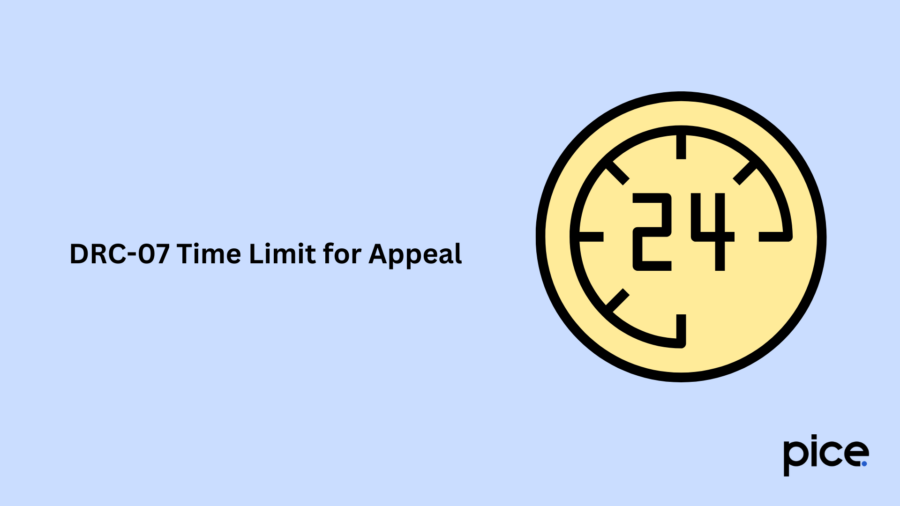
Here are the aspects that you need to know as a taxpayer pertaining to the timeline of appeal:
1. Statutory Time Limit
Taxpayers have to submit their appeal within 30 days from the date of receiving the order in DRC-07.
2. Adherence to the Deadline
In case the taxpayer fails to submit the appeal within the stipulated timeline, he/she will be restricted from contesting the demand any further. In other words, the taxpayer will be liable to pay the outstanding demands mentioned in Form DRC-07 by the proper officer.
3. Extension of Time
If a taxpayer is unable to submit the appeal within the time limit of 30 days from the date of service of the order, he/she can request an extension. However, it is at the sole discretion of the authority to extend the time limit.
How to File Form DRC-07 in GST?
You can follow the steps mentioned below to file Form DRC-07:
Step 1: Visit the GST Portal
Log in to the unified GST portal using your user credentials to reply to DRC-07.
Step 2: Navigate to ‘My Applications’
Go to the ‘Services’ tab on the main dashboard. Look for the dropdown menu and choose ‘User Services’ and then ‘My Application’.
Step 3: Locate Form DRC-07
Multiple GST-related forms are available in the 'My Application' section. You need to find 'Form DRC-07' and click on it to open.
Step 4: Fill in the Necessary Details
Enter the required details in the form.
Step 5: Enter the Grounds for Appeal
You need to specify the grounds for your appeal against the issuance of Form DRC-07.
Step 6: Upload Supporting Documents
To provide evidence of your claims, you need to submit relevant supporting documents in your appeal.
Step 7: Review and Verify
Before you submit the form, ensure to review and verify the details entered.
Step 8: Submit the Form
Once you have reviewed the information entered in the form, click on ‘Submit’ to complete the process.
Step 9: Receive Acknowledgement
Once you submit the form, you will receive an acknowledgement of receipt of the form.
Step 10: Follow Up and Stay Informed
Ensure you check the GST portal for regular updates on the proceedings of your appeal. The tax authorities might update notices or seek additional information based on your claims in the appeal.
Exploring the Legal Framework of DRC-07 Summary Orders
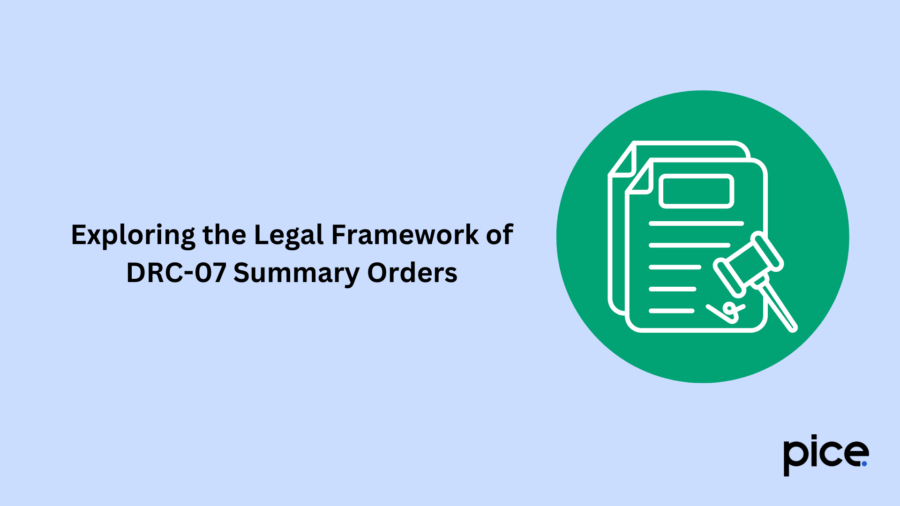
Section 73 (9), 74 (9) and 76 (3) of the Central Goods and Services Tax (CGST) Act, 2017 lays the foundation to issue summary orders in legal proceedings. An appropriate officer needs to upload Form DRC-07 electronically as per Rule 142 (5) after issuing the final order under Section 52, Section 62, Section 63, Section 64, Section 73, Section 75, Section 76, Section 122, Section 123, Section 124, Section 125, Section 127, Section 129 or Section 130.
Form DRC-07 presents the tax amount in addition to the interest and penalties. On submitting Form DRC-07 to the GSTIN, a demand ID needs to be created in the responsibility register Part II. In addition, notices and regulations such as Rule 142 (5) of the CGST Rules, 2017 set the foundation to issue and process DRC-07 summary orders in legal proceedings.
Importance of Compliance with DRC-07 Summary Orders
Taxpayers in India operating under the GST regime, need to ensure compliance with DRC-07 summary orders. If tax authorities identify unpaid tax liabilities pertaining to a GSTIN, they will issue Form DRC-07. This form includes the content and demand of the proper officer while providing the taxpayer with an opportunity to contest or refute.
The proper officer provides a deadline for taxpayers to submit their appeal (if any) against the demand. Taxpayers need to adhere to the deadline to avoid the issuance of final demand notices and recovery orders by the tax authorities.
DRC-07 compliance helps taxpayers fulfil their tax duties and liabilities thereby, avoiding the imposition of penalties and interest charges. It further ensures taxpayers' compliance with GST legislation and legal foundation.
Here are the advantages of complying with DRC-07:
● It helps taxpayers comply with GST laws and regulations while ensuring transparency.
● Taxpayers can engage with the tax authorities to appeal against the demand.
● It helps in the proper recording and processing of demands and recoveries of taxes.
● Taxpayers can avoid late payment of penalties by adhering to the time limit to respond to the tax officer’s demands.
● Tax officers can issue show-cause notices and recovery orders if required.
● It facilitates an open tax administration system in the GST ecosystem.
● The resolution of complaints becomes easier through a seamless GST adjudication process.
● It ensures the proper functioning of the GST supply chain.
● Proper officers can issue final demand notices and recovery orders without any hassle.
● It helps in the timely detection and resolution of tax-related issues.
● It aids in the seamless issuance of orders under Section 73 (9), Section 74 (9) or Section 76 (3) of the CGST Act, 2017.
Challenges and Complexities in Implementing DRC-07 Summary Orders
Here are the challenges and complexities in implementing DRC-07 summary orders:
1. Complex Tax Calculations
DRC-07 summary orders include various tax calculations such as valuation, classification, rate of tax and others. It can be difficult for GSTIN holders to understand and comply with.
2. Multiple Issues Involved
This form includes multiple topics such as categorisation, tax rate, value, suppression of turnover, excess refund released and excess input tax credit (ITC). As a result, it often becomes difficult for taxpayers to reply appropriately to this form.
3. Short Response Time
The tax authorities provide the taxpayers with a specific deadline to respond to DRC-07. Taxpayers might face challenges in replying within the specific timeline due to multiple orders or complex issues.
4. Insufficient Direction
Taxpayers might find the regulations and notifications pertaining to the issuance and processing of DRC-07 confusing. It results in a lack of direction for GSTIN holders.
5. Resolution of Disputes
Resolution of legal implications of DRC-07 often takes multiple years. Taxpayers can thus face challenges in terms of legal consequences for a long period of time.
6. Adherence to GST Rules and Laws
When there are a large number of orders, taxpayers find it difficult to comply with GST laws and regulations. This results in complexities and complications.
7. Identifying Errors
GSTIN holders need to identify and address the errors in Form DRC-07. However, they face challenges in the process when there are multiple orders.
8. Lack of Proper Training
Taxpayers might face challenges in replying to DRC-07 due to a lack of training and resources. As a result, they might fail to respond to the form within the stipulated deadline.
9. Manual Processing
Usually, the proper officer issues Form DRC-07 electronically. However, if he/she issues the form manually, it might be difficult for taxpayers to track online resulting in compliance issues.
10. Implementing Irregularities
Tax officers might apply DRC-07 orders to different taxpayers in distinguishing ways. This makes it difficult for taxpayers to align with the directives of tax officers.
11. Adjudication Procedure
Taxpayers mandatorily have to participate in the adjudication process of Form DRC-07. However, as it is a time-consuming process, taxpayers might face challenges in participating.
12. Record-keeping
Taxpayers need to provide supporting documents to appeal against a demand issued in Form DRC-07. However, they might face challenges in maintaining records and presenting them.
13. Lack of Clarity
GSTIN holders might face difficulties understanding the rules and notifications pertaining to the issuance and processing of DRC-07. As a result, they lack clarity in responding to the form.
14. Regulatory Changes
The tax authorities might change the regulations and rules pertaining to DRC-07 periodically. If the taxpayers are unaware or not updated about the regulatory changes, it is challenging for them to understand the details of the form.
DRC-07 Among Other GST Notices
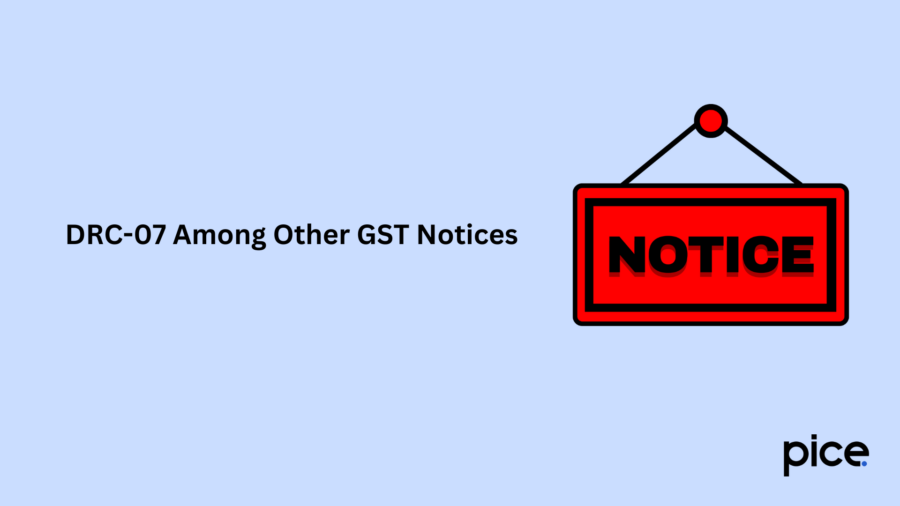
The GST system entrusts proper officers to issue several notices to taxpayers for transparency and compliance. These notices are issued when the tax officer identifies discrepancies in tax filings, errors in ITC claims or mismatched data. Issuance of the notices helps the GST system ensure a complaint tax structure. Here are the notices that proper officers issue:
● DRC-01: If a GST authority detects potential tax evasion or errors, it issues DRC-01 as a show cause notice to the taxpayer to seek clarification on tax dues.
● DRC-03: This form enables taxpayers to rectify their returns voluntarily by paying additional tax liabilities and declaring the same.
● DRC-07: After the assessment of taxes, the tax authorities issue Form DRC-07 to taxpayers to intimate businesses about a confirmed tax shortfall.
● DRC-08: A GST officer issues Form DRC-08 to taxpayers to inform them about refund adjustments against the taxpayer's liabilities.
How Does DRC-07 Differ from Other GST Notices?
Here are the purposes to issue DRC-03, DRC-07 and DRC-08:
● DRC-03: DRC-03 is a voluntary payment notice that the proper officer issues to taxpayers. It allows GSTIN holders to assess and identify errors in their previous returns to pay additional tax liabilities.
● DRC-07: The tax authorities issue DRC-07 as an official demand notice to confirm the tax liability of taxpayers. Based on an assessment by the proper officer, the issuance of Form DRC-07 mandates payment of outstanding tax dues within a stipulated period.
● DRC-08: The issuance of DRC-08 informs taxpayers about fund reallocations. This notice further intimates GSTIN holders of refund adjustments against pending tax dues.
Key Stakeholders Involved
Here are the key stakeholders involved in the issuance of DRC-07 followed by their roles:
● GST Officer: He/she issues the notice on behalf of the tax authorities.
● Taxpayers: The GSTIN holder receiving the notice.
● Legal Representatives: If the taxpayer engages a legal representative.
● Tax Consultants: Businesses might seek help from tax consultants in filing DRC-07.
Common Mistakes and Tips for Compliance with DRC-07
As a taxpayer, you can follow the tips mentioned below to avoid the specified common mistakes:
● Ignoring the Notice
Businesses might overlook a DRC-07 notice due to several reasons. It will likely lead to interest and penalties on the tax amount for the taxpayer. Ensure you act on the notice immediately after you receive it.
● Incomplete or Incorrect Documentation
As a taxpayer, you might submit incomplete or incorrect documents, including mismatched invoices or incomplete reconciliations. This results in further scrutiny by the tax authorities. To avoid this, you need to submit accurate and updated documents.
● Delaying Payments
If you receive a notice regarding additional tax due payment, ensure you pay it within the stipulated time frame. Alternatively, if you disagree with the demands of the proper officer, you need to respond with an appeal within the defined timeline. It is essential to undertake either of the actions mentioned above to avoid non-compliance with GST laws.
● Failure to Cross-check with GSTR Filings
Proper officers often issue DRC-07 due to a mismatch between GSTR-1 and GSTR-3B filings. As a business, ensure you reconcile these records before you respond to the proper officer in an appeal.
Ways to Avoid Issuance of Notices
Here are the ways you can comply with GST regulations to avoid receiving notices from the GST authorities:
● Ensure you reconcile GSTR-1 and GSTR-3B on a regular basis to detect errors and discrepancies
● Minimise manual errors in tax calculations, ITC claims, and tax filings by using reliable automated GST software.
● As a taxpayer, stay updated about the GST amendments to comply with the laws and regulations.
● Consult a GST expert or tax professional to respond, reduce errors and improve accuracy in responses. This helps you align with the GST laws to avoid risks of penalties, interest and legal issues.
Process of Replying to Form DRC-07
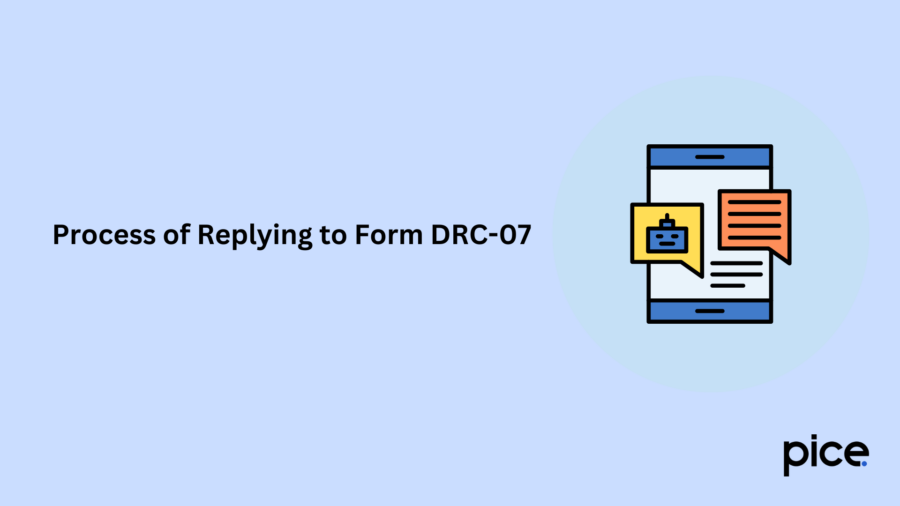
As a taxpayer, you need to follow the process mentioned below to reply to DRC-07:
1. Review the Notice Carefully
If you receive a DRC-07 notice from the proper officer, ensure to verify the tax amount due, penalties, interest and other discrepancies. Further, verify the reason for receiving the notice such as underreported income, ITC issues or mismatched filings.
2. Prepare Required Documentation
To validate your claims ensure you have all the records pertaining to taxes such as invoices, purchase receipts, tax returns, ITC claims and others. You need to cross-check the details in these documents with the notice to ensure they are the same.
3. Calculate Outstanding Tax Liability
Before you respond to the notice, calculate the actual tax due followed by the applicable interest or penalties. Moreover, include accurate figures in your reply. If there is a mismatch due to excessive ITC claims, ensure you adjust your ITC claims for compliance with GST regulations.
4. Reply Through the GST Portal
Once you are ready with the documents and calculations, visit the official GST portal. Navigate to the ‘Notices’ section and look for the DRC-07 option. Enter your response clarifying the discrepancies. Ensure you attach relevant supporting documents to address the discrepancies in the notice. The supporting documents might include corrected ITC records, invoices or proof of payments.
5. Pay the Necessary Amount
As a GSTIN holder, if you agree with the discrepancies in Form DRC-07, you need to pay the outstanding tax liabilities within the specified time limit. On paying the tax dues, submit for DRC-03 to self-declare the amount and notify the proper officer. Ensure you pay the dues within the deadline to avoid the imposition of additional penalties or case escalation.
6. Track Acknowledgement Status
To ensure that your response has been submitted successfully, check for an acknowledgement that the GST authorities send. The proper officer might seek further justifications for the case. You can track such notices or request for additional documents by the GST authorities on the unified GST portal.
Importance of Timely Response to DRC-07 Notice
A timely reply to the DRC-07 notice is crucial for the following reasons:
● Avoiding penalties and interest on the tax amount
● To prevent legal escalation in the Tribunal Court
● Improve business credibility with a clean compliance record and resolution of tax discrepancies
● To be eligible for ITC and GST refunds
Conclusion
Responding to Form DRC-07 in GST within the stipulated time period can help taxpayers avoid paying penalties and interest. It further eliminates adverse legal consequences for the taxpayer. Ensure you initiate the appeal following the appropriate process.
In case you accept the discrepancies in the tax demand notice issued by the proper officer, you need to pay the outstanding tax dues along with the applicable penalties and interest. Adhering to the timeline for payment of the dues is essential for taxpayers to avoid legal implications and ensure compliance with GST laws.
💡If you want to streamline your payment and make GST payments, consider using the PICE App. Explore the PICE App today and take your business to new heights.
FAQs
 By
By 








